Factors Influencing Biosecurity Practices of Dairy Farmers in Pothwar
VerifiedAdded on 2021/08/19
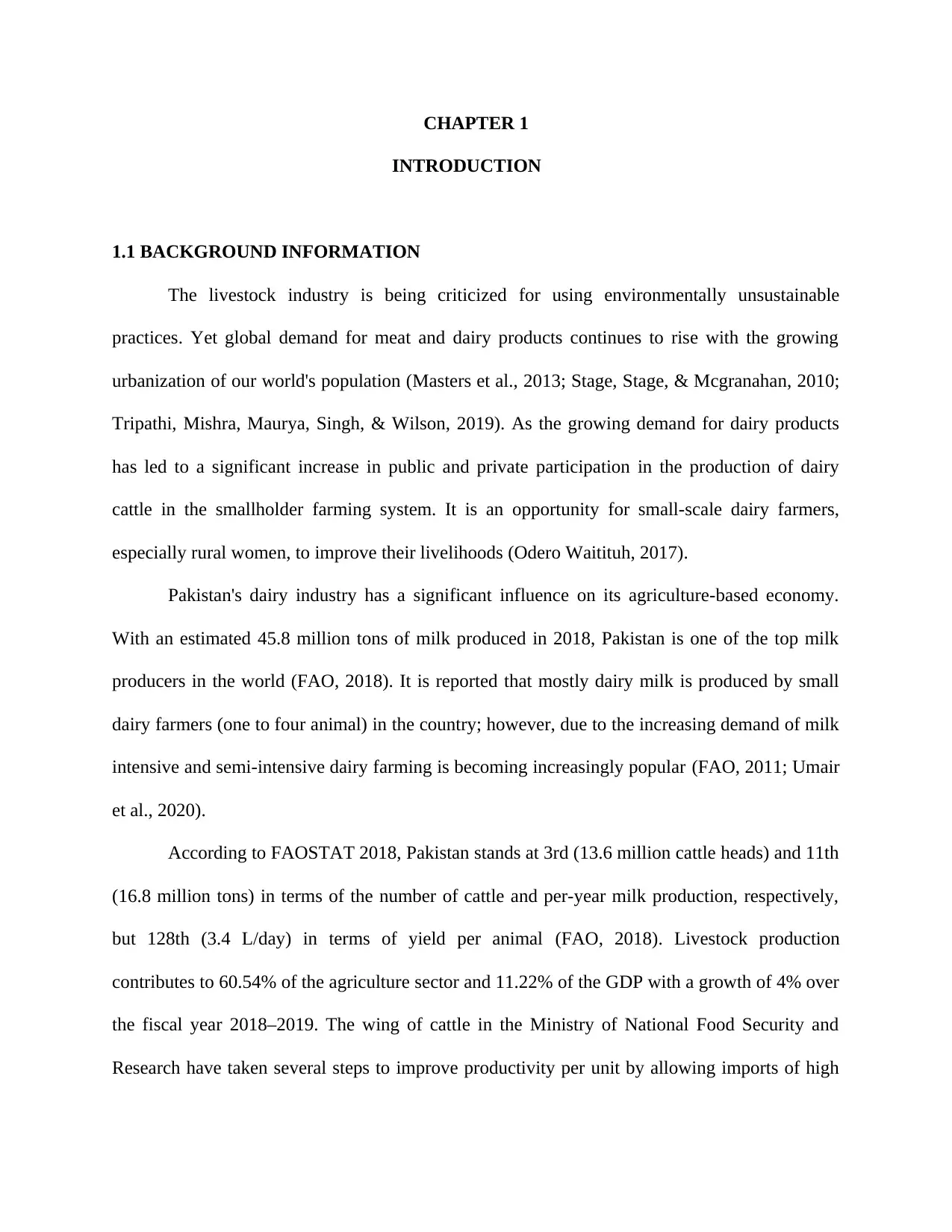
INTRODUCTION
1.1 BACKGROUND INFORMATION
The livestock industry is being criticized for using environmentally unsustainable
practices. Yet global demand for meat and dairy products continues to rise with the growing
urbanization of our world's population (Masters et al., 2013; Stage, Stage, & Mcgranahan, 2010;
Tripathi, Mishra, Maurya, Singh, & Wilson, 2019). As the growing demand for dairy products
has led to a significant increase in public and private participation in the production of dairy
cattle in the smallholder farming system. It is an opportunity for small-scale dairy farmers,
especially rural women, to improve their livelihoods (Odero Waitituh, 2017).
Pakistan's dairy industry has a significant influence on its agriculture-based economy.
With an estimated 45.8 million tons of milk produced in 2018, Pakistan is one of the top milk
producers in the world (FAO, 2018). It is reported that mostly dairy milk is produced by small
dairy farmers (one to four animal) in the country; however, due to the increasing demand of milk
intensive and semi-intensive dairy farming is becoming increasingly popular (FAO, 2011; Umair
et al., 2020).
According to FAOSTAT 2018, Pakistan stands at 3rd (13.6 million cattle heads) and 11th
(16.8 million tons) in terms of the number of cattle and per-year milk production, respectively,
but 128th (3.4 L/day) in terms of yield per animal (FAO, 2018). Livestock production
contributes to 60.54% of the agriculture sector and 11.22% of the GDP with a growth of 4% over
the fiscal year 2018–2019. The wing of cattle in the Ministry of National Food Security and
Research have taken several steps to improve productivity per unit by allowing imports of high
Paraphrase This Document
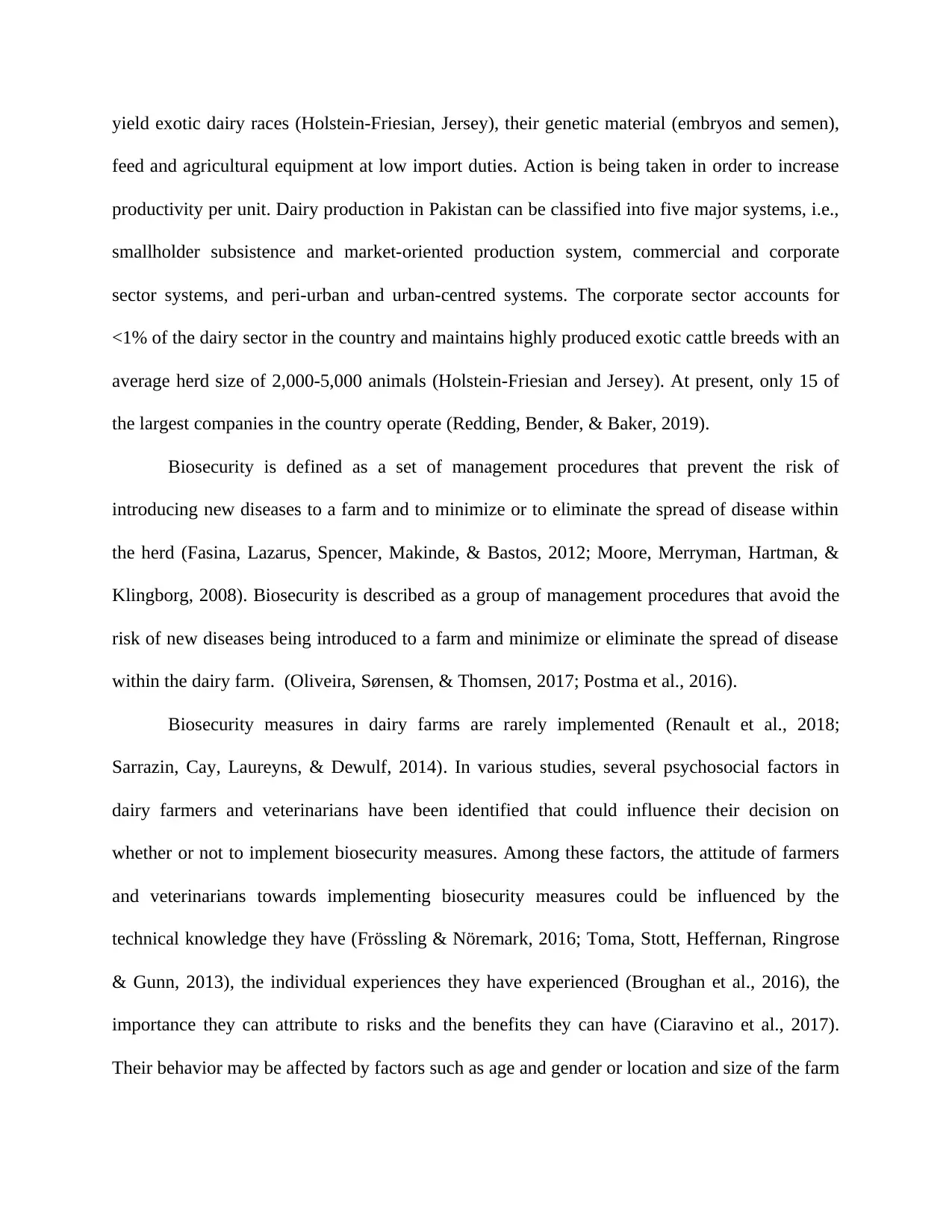
feed and agricultural equipment at low import duties. Action is being taken in order to increase
productivity per unit. Dairy production in Pakistan can be classified into five major systems, i.e.,
smallholder subsistence and market-oriented production system, commercial and corporate
sector systems, and peri-urban and urban-centred systems. The corporate sector accounts for
<1% of the dairy sector in the country and maintains highly produced exotic cattle breeds with an
average herd size of 2,000-5,000 animals (Holstein-Friesian and Jersey). At present, only 15 of
the largest companies in the country operate (Redding, Bender, & Baker, 2019).
Biosecurity is defined as a set of management procedures that prevent the risk of
introducing new diseases to a farm and to minimize or to eliminate the spread of disease within
the herd (Fasina, Lazarus, Spencer, Makinde, & Bastos, 2012; Moore, Merryman, Hartman, &
Klingborg, 2008). Biosecurity is described as a group of management procedures that avoid the
risk of new diseases being introduced to a farm and minimize or eliminate the spread of disease
within the dairy farm. (Oliveira, Sørensen, & Thomsen, 2017; Postma et al., 2016).
Biosecurity measures in dairy farms are rarely implemented (Renault et al., 2018;
Sarrazin, Cay, Laureyns, & Dewulf, 2014). In various studies, several psychosocial factors in
dairy farmers and veterinarians have been identified that could influence their decision on
whether or not to implement biosecurity measures. Among these factors, the attitude of farmers
and veterinarians towards implementing biosecurity measures could be influenced by the
technical knowledge they have (Frössling & Nöremark, 2016; Toma, Stott, Heffernan, Ringrose
& Gunn, 2013), the individual experiences they have experienced (Broughan et al., 2016), the
importance they can attribute to risks and the benefits they can have (Ciaravino et al., 2017).
Their behavior may be affected by factors such as age and gender or location and size of the farm
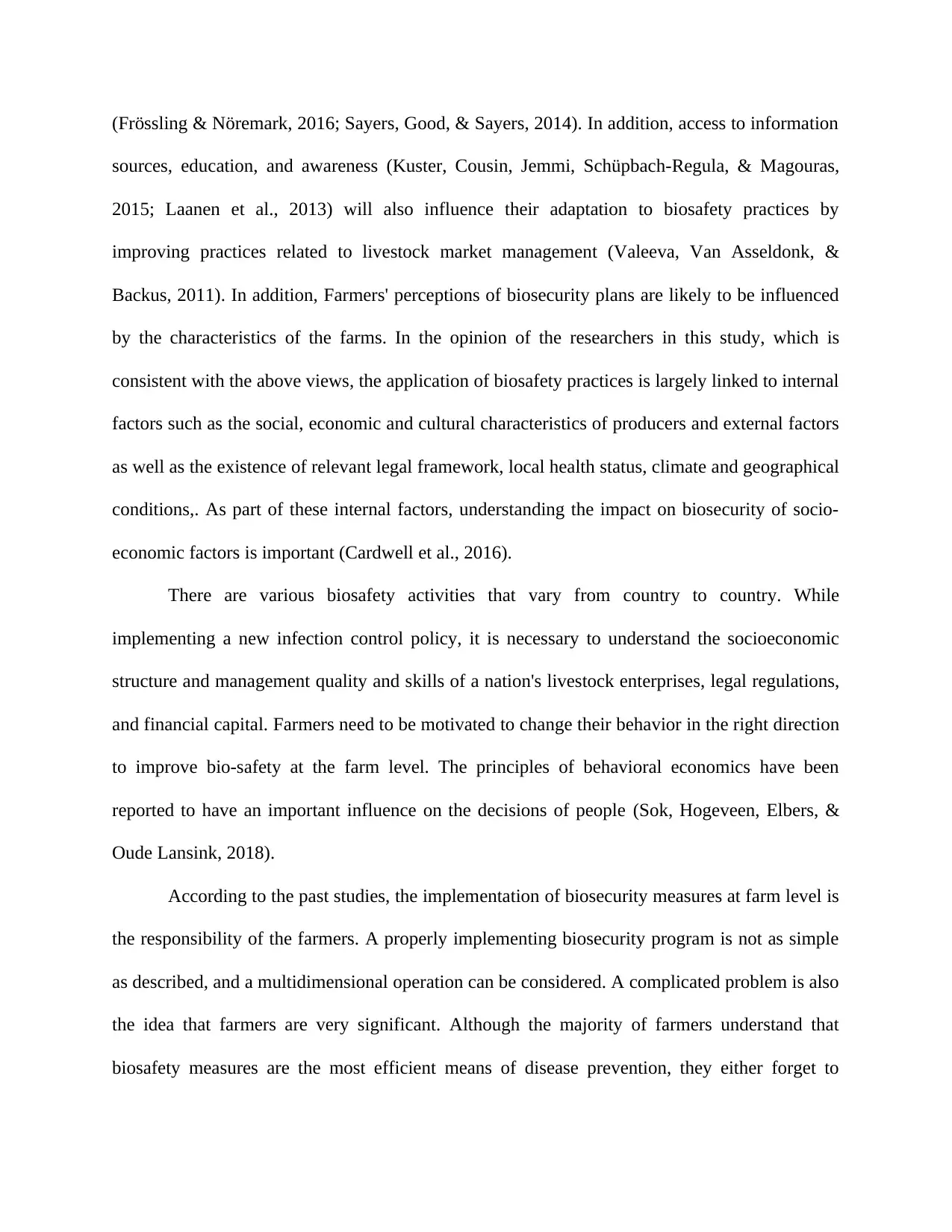
sources, education, and awareness (Kuster, Cousin, Jemmi, Schüpbach-Regula, & Magouras,
2015; Laanen et al., 2013) will also influence their adaptation to biosafety practices by
improving practices related to livestock market management (Valeeva, Van Asseldonk, &
Backus, 2011). In addition, Farmers' perceptions of biosecurity plans are likely to be influenced
by the characteristics of the farms. In the opinion of the researchers in this study, which is
consistent with the above views, the application of biosafety practices is largely linked to internal
factors such as the social, economic and cultural characteristics of producers and external factors
as well as the existence of relevant legal framework, local health status, climate and geographical
conditions,. As part of these internal factors, understanding the impact on biosecurity of socio-
economic factors is important (Cardwell et al., 2016).
There are various biosafety activities that vary from country to country. While
implementing a new infection control policy, it is necessary to understand the socioeconomic
structure and management quality and skills of a nation's livestock enterprises, legal regulations,
and financial capital. Farmers need to be motivated to change their behavior in the right direction
to improve bio-safety at the farm level. The principles of behavioral economics have been
reported to have an important influence on the decisions of people (Sok, Hogeveen, Elbers, &
Oude Lansink, 2018).
According to the past studies, the implementation of biosecurity measures at farm level is
the responsibility of the farmers. A properly implementing biosecurity program is not as simple
as described, and a multidimensional operation can be considered. A complicated problem is also
the idea that farmers are very significant. Although the majority of farmers understand that
biosafety measures are the most efficient means of disease prevention, they either forget to
⊘ This is a preview!⊘
Do you want full access?
Subscribe today to unlock all pages.

Trusted by 1+ million students worldwide

Martin, 2007; Moore et al., 2008).
Small farms play an important role in rural economic development and poverty reduction
among farmers, especially in developing countries. Nevertheless, in recent years, small
manufacturers have faced a variety of obstacles, both financial, technological and legal. The
majority of farms are still produced in small scale (Can, 2014; Uddin, Uddin, Al Mamun,
Hassan, & Khan, 2012).
Pakistan's economy depends primarily on rural people's agriculture being linked to
agriculture. Worldwide, about 1.8 billion people are involved in agriculture and use pesticides to
combat mosquitoes, pests, and diseases and ensure safe crop growth and livestock farming
medication. In Pakistan, animals are not only used for plowing and transport, but they also meet
the household needs for dairy products such as milk, butter, whey and yogurt. It improves rural
households' income and safety in crop failures, especially in areas fed by rain. It is the best
source of jobs in rural and urban areas, helping to minimize income variance. It also plays a
significant role in the country's poverty alleviation. Agricultural production is a critical task for
landless farmers. In human diets, livelihoods, employment, and possibly foreign exchange,
livestock provide food or animal protein (Farid, Siddiqui, Mustafa, & Dawood, 2018).
Livestock is an important component of rural farming in Pakistan because animals are
used not only for plowing and transportation but also for dairy products such as milk, butter,
cheese and yogurt. It also boosts rural household income and can act as a safety net, especially in
rain-fed areas, in crop failures (Shafee, Rabbani, Sheikh & Razzaq, 2011). It is the best source of
jobs in both rural and urban areas helping to minimize income variation. It also plays an
important role in alleviating poverty in the region. The landless farmers find livestock production
Paraphrase This Document
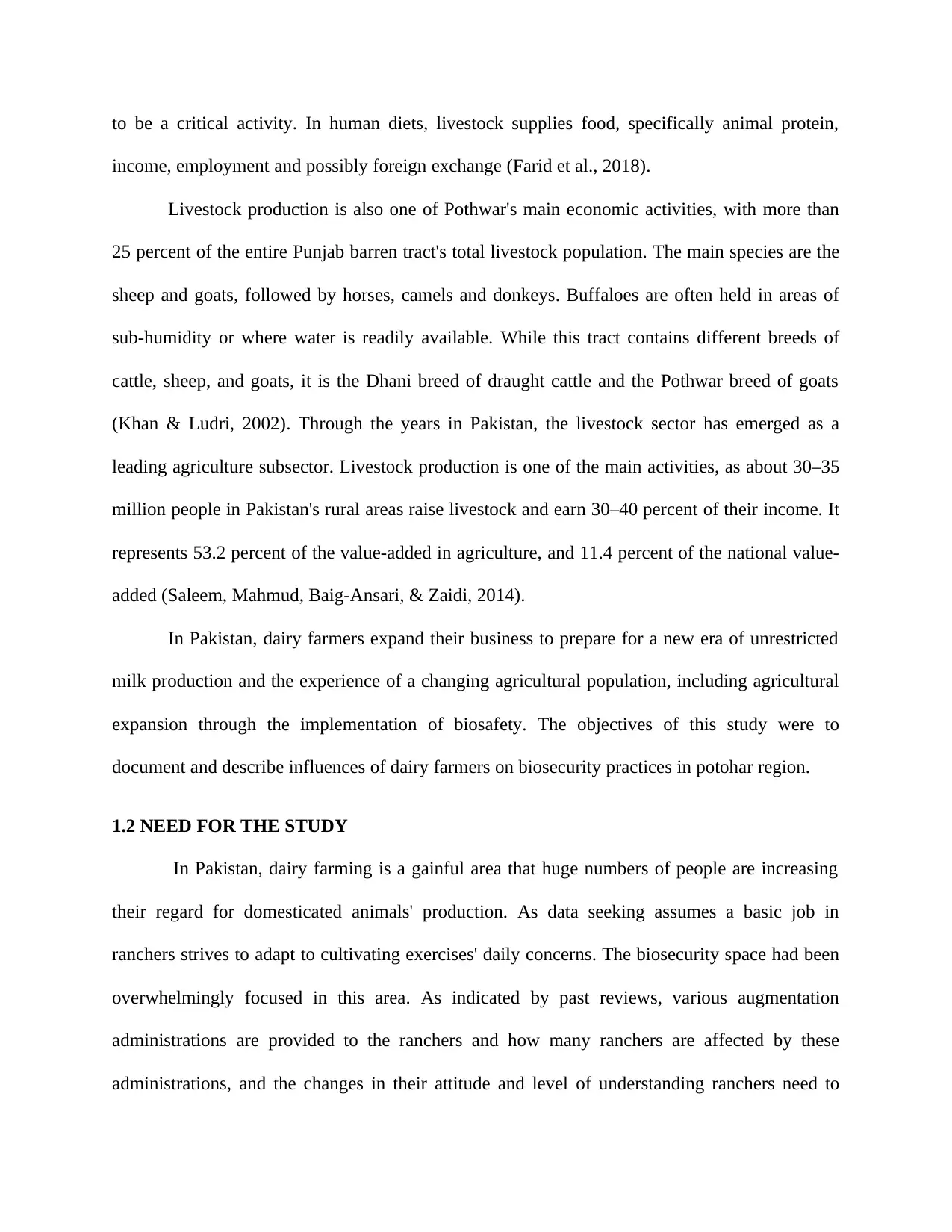
income, employment and possibly foreign exchange (Farid et al., 2018).
Livestock production is also one of Pothwar's main economic activities, with more than
25 percent of the entire Punjab barren tract's total livestock population. The main species are the
sheep and goats, followed by horses, camels and donkeys. Buffaloes are often held in areas of
sub-humidity or where water is readily available. While this tract contains different breeds of
cattle, sheep, and goats, it is the Dhani breed of draught cattle and the Pothwar breed of goats
(Khan & Ludri, 2002). Through the years in Pakistan, the livestock sector has emerged as a
leading agriculture subsector. Livestock production is one of the main activities, as about 30–35
million people in Pakistan's rural areas raise livestock and earn 30–40 percent of their income. It
represents 53.2 percent of the value-added in agriculture, and 11.4 percent of the national value-
added (Saleem, Mahmud, Baig-Ansari, & Zaidi, 2014).
In Pakistan, dairy farmers expand their business to prepare for a new era of unrestricted
milk production and the experience of a changing agricultural population, including agricultural
expansion through the implementation of biosafety. The objectives of this study were to
document and describe influences of dairy farmers on biosecurity practices in potohar region.
1.2 NEED FOR THE STUDY
In Pakistan, dairy farming is a gainful area that huge numbers of people are increasing
their regard for domesticated animals' production. As data seeking assumes a basic job in
ranchers strives to adapt to cultivating exercises' daily concerns. The biosecurity space had been
overwhelmingly focused in this area. As indicated by past reviews, various augmentation
administrations are provided to the ranchers and how many ranchers are affected by these
administrations, and the changes in their attitude and level of understanding ranchers need to
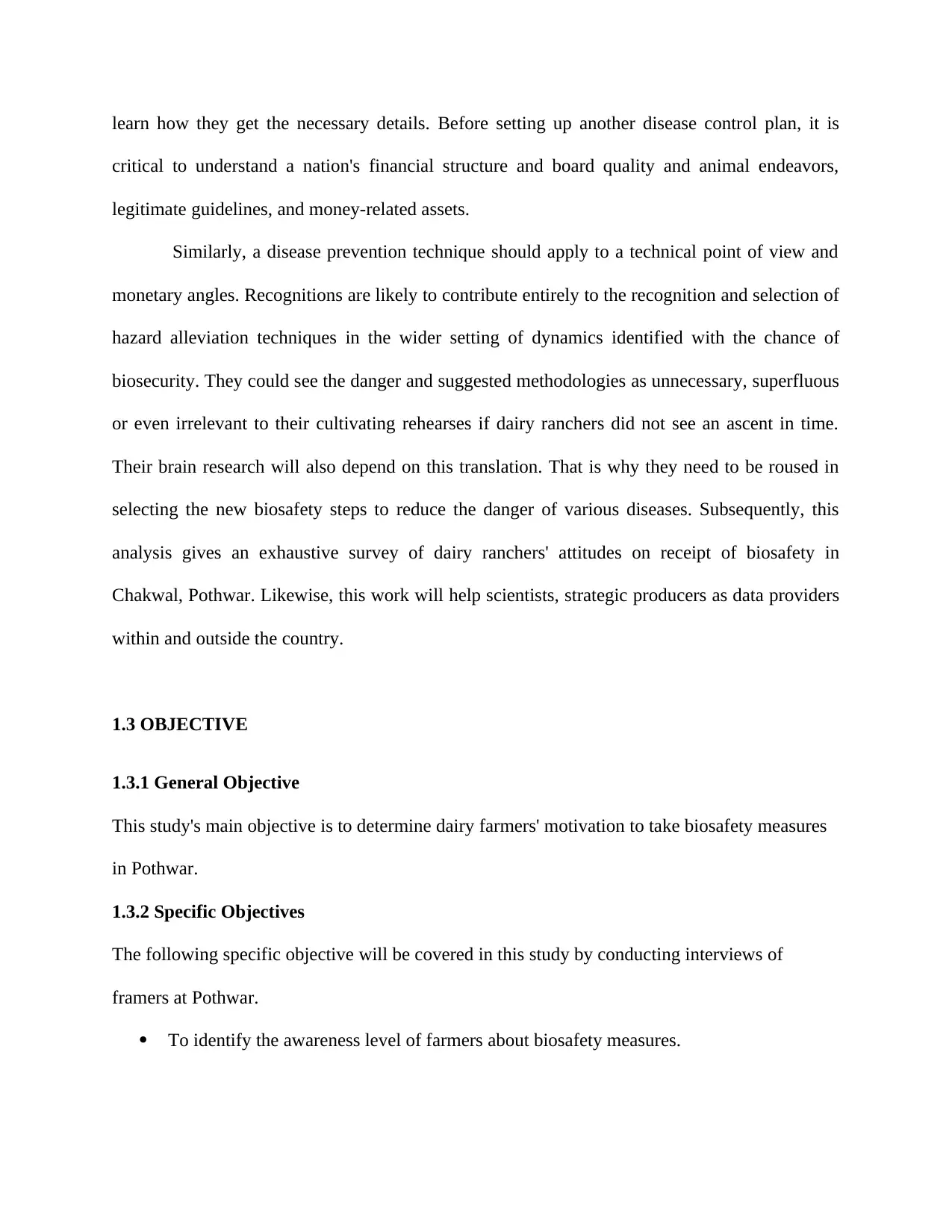
critical to understand a nation's financial structure and board quality and animal endeavors,
legitimate guidelines, and money-related assets.
Similarly, a disease prevention technique should apply to a technical point of view and
monetary angles. Recognitions are likely to contribute entirely to the recognition and selection of
hazard alleviation techniques in the wider setting of dynamics identified with the chance of
biosecurity. They could see the danger and suggested methodologies as unnecessary, superfluous
or even irrelevant to their cultivating rehearses if dairy ranchers did not see an ascent in time.
Their brain research will also depend on this translation. That is why they need to be roused in
selecting the new biosafety steps to reduce the danger of various diseases. Subsequently, this
analysis gives an exhaustive survey of dairy ranchers' attitudes on receipt of biosafety in
Chakwal, Pothwar. Likewise, this work will help scientists, strategic producers as data providers
within and outside the country.
1.3 OBJECTIVE
1.3.1 General Objective
This study's main objective is to determine dairy farmers' motivation to take biosafety measures
in Pothwar.
1.3.2 Specific Objectives
The following specific objective will be covered in this study by conducting interviews of
framers at Pothwar.
To identify the awareness level of farmers about biosafety measures.
⊘ This is a preview!⊘
Do you want full access?
Subscribe today to unlock all pages.

Trusted by 1+ million students worldwide
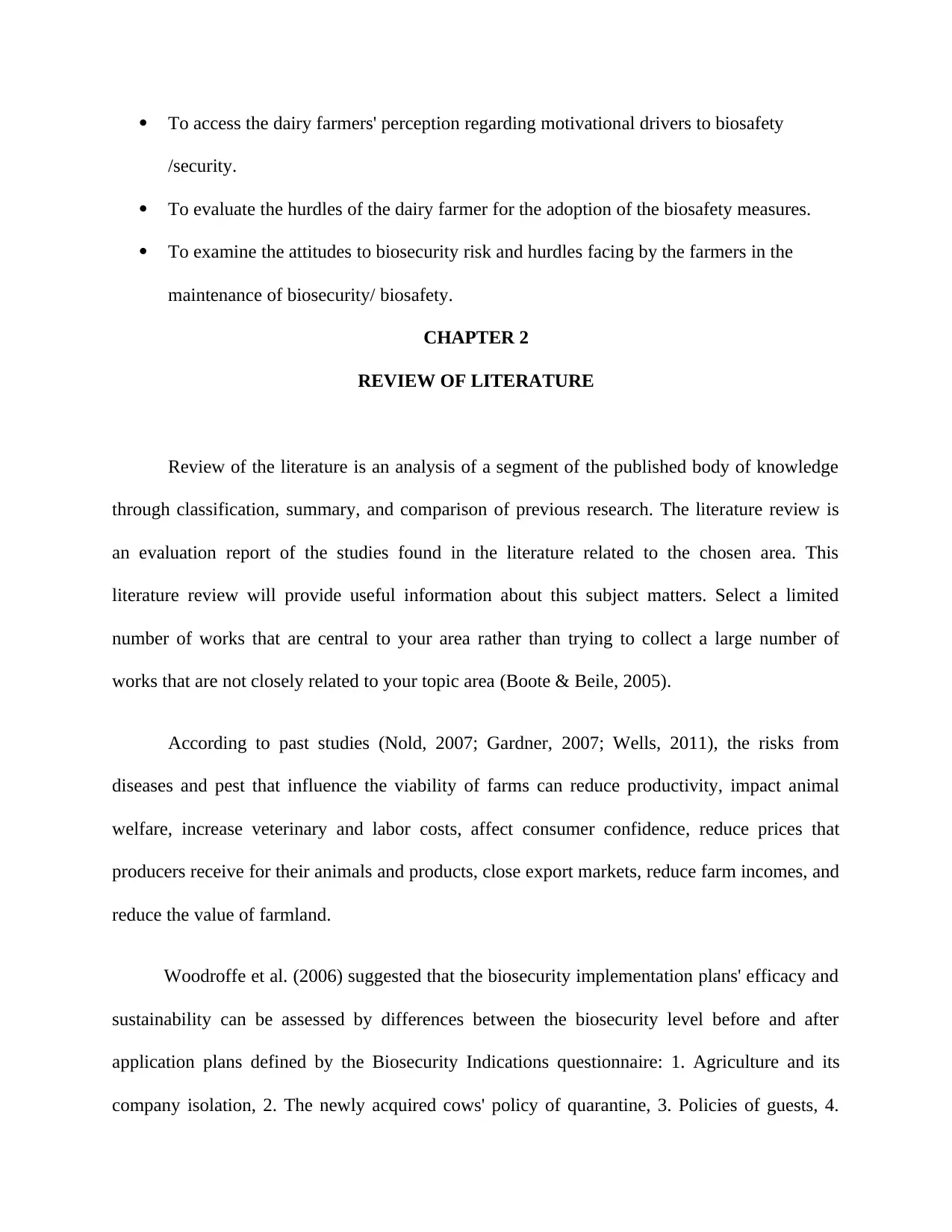
/security.
To evaluate the hurdles of the dairy farmer for the adoption of the biosafety measures.
To examine the attitudes to biosecurity risk and hurdles facing by the farmers in the
maintenance of biosecurity/ biosafety.
CHAPTER 2
REVIEW OF LITERATURE
Review of the literature is an analysis of a segment of the published body of knowledge
through classification, summary, and comparison of previous research. The literature review is
an evaluation report of the studies found in the literature related to the chosen area. This
literature review will provide useful information about this subject matters. Select a limited
number of works that are central to your area rather than trying to collect a large number of
works that are not closely related to your topic area (Boote & Beile, 2005).
According to past studies (Nold, 2007; Gardner, 2007; Wells, 2011), the risks from
diseases and pest that influence the viability of farms can reduce productivity, impact animal
welfare, increase veterinary and labor costs, affect consumer confidence, reduce prices that
producers receive for their animals and products, close export markets, reduce farm incomes, and
reduce the value of farmland.
Woodroffe et al. (2006) suggested that the biosecurity implementation plans' efficacy and
sustainability can be assessed by differences between the biosecurity level before and after
application plans defined by the Biosecurity Indications questionnaire: 1. Agriculture and its
company isolation, 2. The newly acquired cows' policy of quarantine, 3. Policies of guests, 4.
Paraphrase This Document
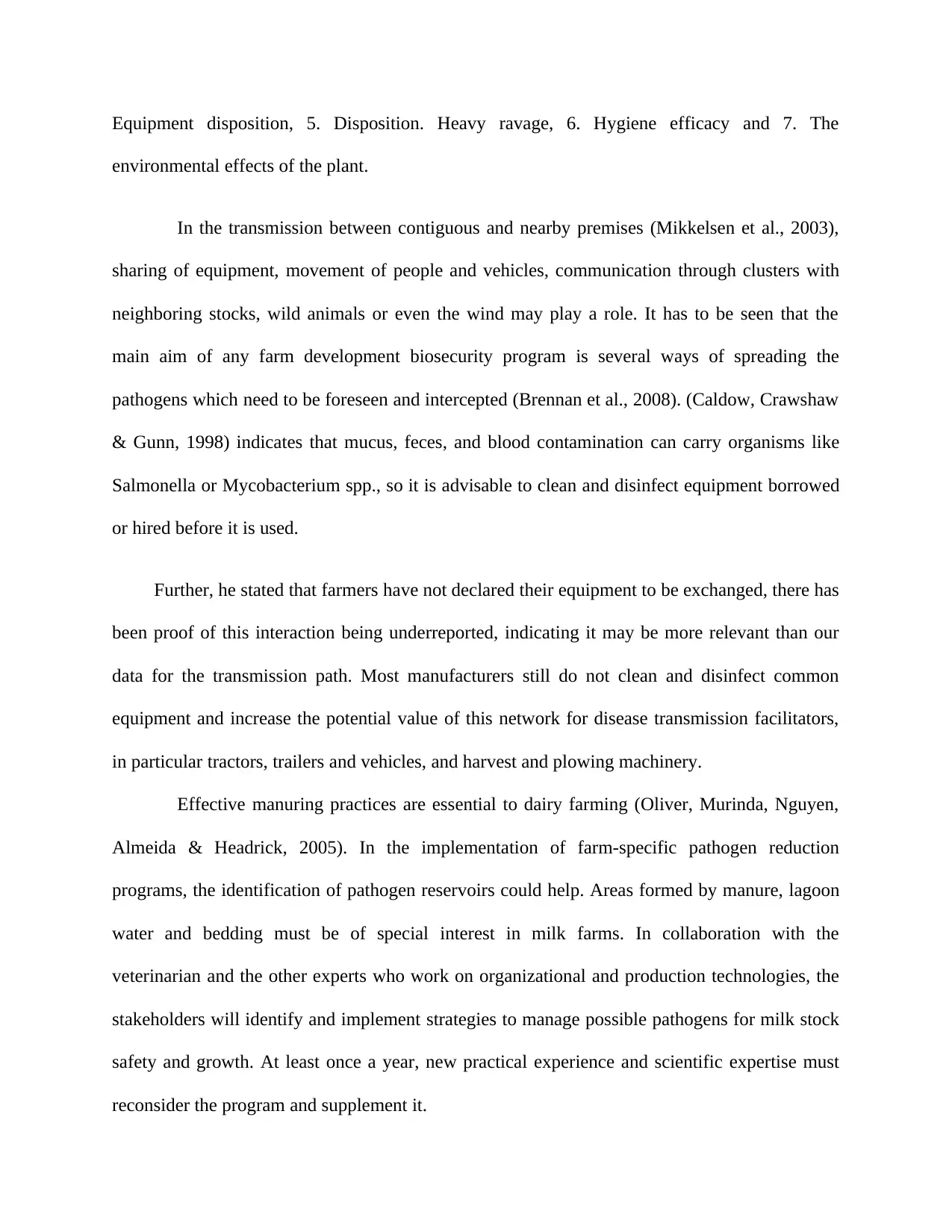
environmental effects of the plant.
In the transmission between contiguous and nearby premises (Mikkelsen et al., 2003),
sharing of equipment, movement of people and vehicles, communication through clusters with
neighboring stocks, wild animals or even the wind may play a role. It has to be seen that the
main aim of any farm development biosecurity program is several ways of spreading the
pathogens which need to be foreseen and intercepted (Brennan et al., 2008). (Caldow, Crawshaw
& Gunn, 1998) indicates that mucus, feces, and blood contamination can carry organisms like
Salmonella or Mycobacterium spp., so it is advisable to clean and disinfect equipment borrowed
or hired before it is used.
Further, he stated that farmers have not declared their equipment to be exchanged, there has
been proof of this interaction being underreported, indicating it may be more relevant than our
data for the transmission path. Most manufacturers still do not clean and disinfect common
equipment and increase the potential value of this network for disease transmission facilitators,
in particular tractors, trailers and vehicles, and harvest and plowing machinery.
Effective manuring practices are essential to dairy farming (Oliver, Murinda, Nguyen,
Almeida & Headrick, 2005). In the implementation of farm-specific pathogen reduction
programs, the identification of pathogen reservoirs could help. Areas formed by manure, lagoon
water and bedding must be of special interest in milk farms. In collaboration with the
veterinarian and the other experts who work on organizational and production technologies, the
stakeholders will identify and implement strategies to manage possible pathogens for milk stock
safety and growth. At least once a year, new practical experience and scientific expertise must
reconsider the program and supplement it.
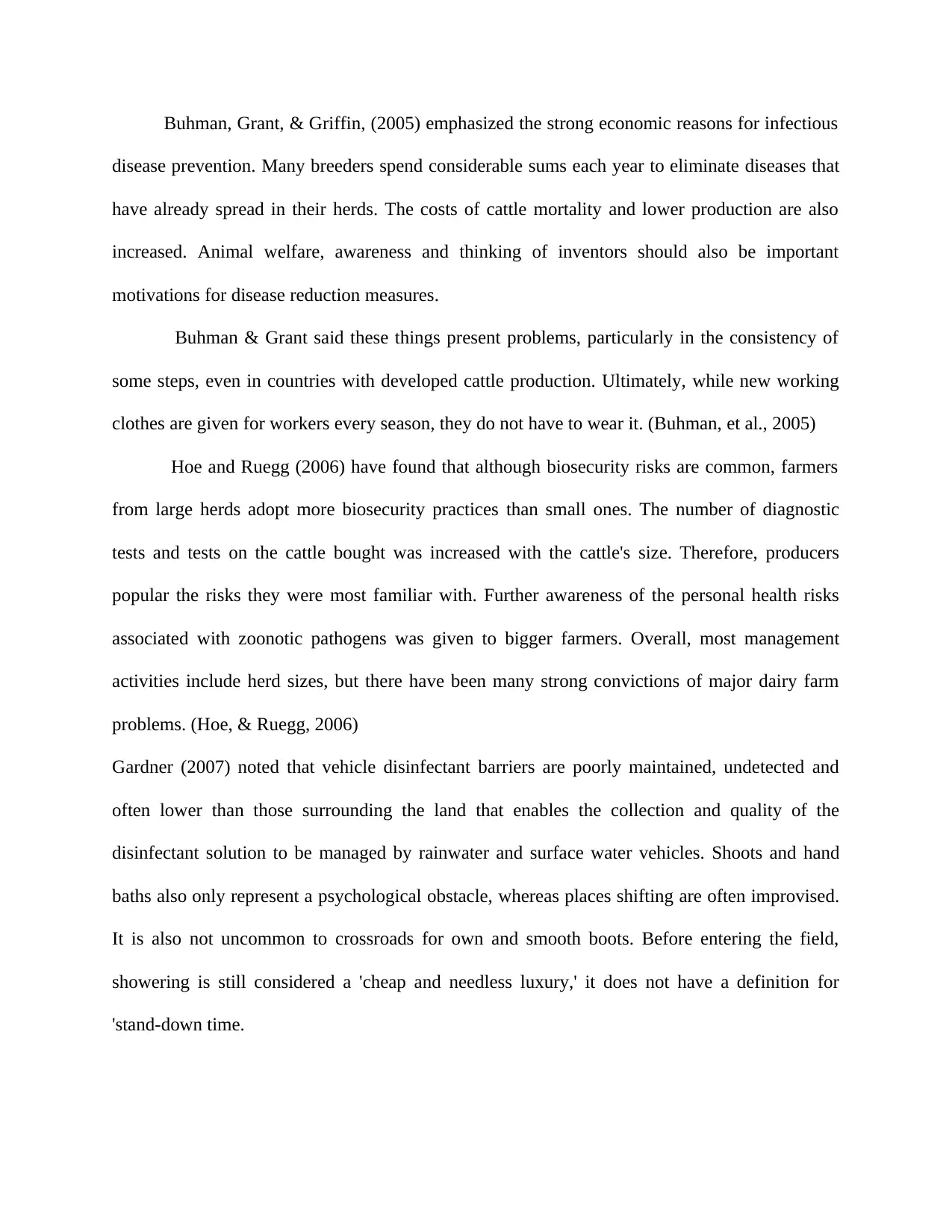
disease prevention. Many breeders spend considerable sums each year to eliminate diseases that
have already spread in their herds. The costs of cattle mortality and lower production are also
increased. Animal welfare, awareness and thinking of inventors should also be important
motivations for disease reduction measures.
Buhman & Grant said these things present problems, particularly in the consistency of
some steps, even in countries with developed cattle production. Ultimately, while new working
clothes are given for workers every season, they do not have to wear it. (Buhman, et al., 2005)
Hoe and Ruegg (2006) have found that although biosecurity risks are common, farmers
from large herds adopt more biosecurity practices than small ones. The number of diagnostic
tests and tests on the cattle bought was increased with the cattle's size. Therefore, producers
popular the risks they were most familiar with. Further awareness of the personal health risks
associated with zoonotic pathogens was given to bigger farmers. Overall, most management
activities include herd sizes, but there have been many strong convictions of major dairy farm
problems. (Hoe, & Ruegg, 2006)
Gardner (2007) noted that vehicle disinfectant barriers are poorly maintained, undetected and
often lower than those surrounding the land that enables the collection and quality of the
disinfectant solution to be managed by rainwater and surface water vehicles. Shoots and hand
baths also only represent a psychological obstacle, whereas places shifting are often improvised.
It is also not uncommon to crossroads for own and smooth boots. Before entering the field,
showering is still considered a 'cheap and needless luxury,' it does not have a definition for
'stand-down time.
⊘ This is a preview!⊘
Do you want full access?
Subscribe today to unlock all pages.

Trusted by 1+ million students worldwide
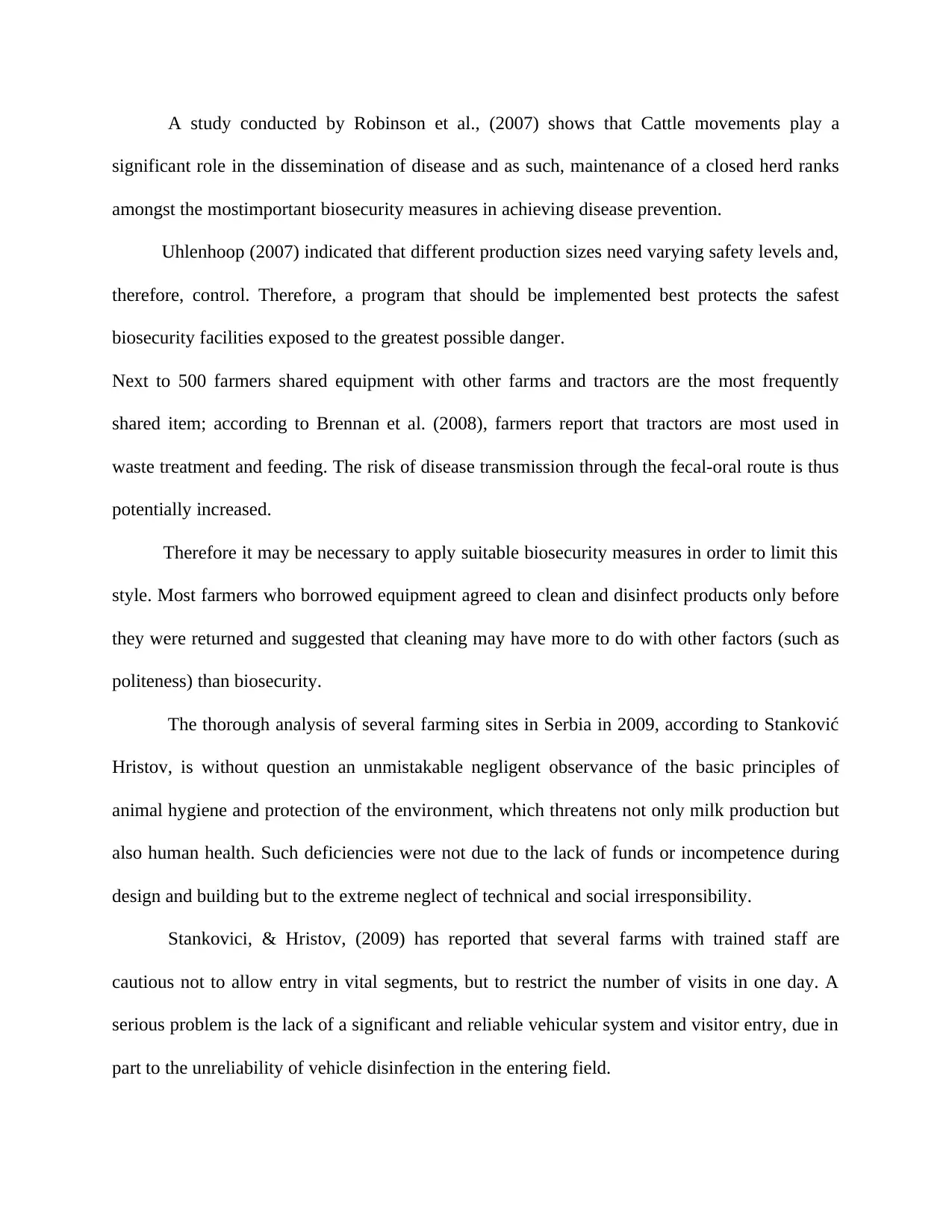
significant role in the dissemination of disease and as such, maintenance of a closed herd ranks
amongst the mostimportant biosecurity measures in achieving disease prevention.
Uhlenhoop (2007) indicated that different production sizes need varying safety levels and,
therefore, control. Therefore, a program that should be implemented best protects the safest
biosecurity facilities exposed to the greatest possible danger.
Next to 500 farmers shared equipment with other farms and tractors are the most frequently
shared item; according to Brennan et al. (2008), farmers report that tractors are most used in
waste treatment and feeding. The risk of disease transmission through the fecal-oral route is thus
potentially increased.
Therefore it may be necessary to apply suitable biosecurity measures in order to limit this
style. Most farmers who borrowed equipment agreed to clean and disinfect products only before
they were returned and suggested that cleaning may have more to do with other factors (such as
politeness) than biosecurity.
The thorough analysis of several farming sites in Serbia in 2009, according to Stanković
Hristov, is without question an unmistakable negligent observance of the basic principles of
animal hygiene and protection of the environment, which threatens not only milk production but
also human health. Such deficiencies were not due to the lack of funds or incompetence during
design and building but to the extreme neglect of technical and social irresponsibility.
Stankovici, & Hristov, (2009) has reported that several farms with trained staff are
cautious not to allow entry in vital segments, but to restrict the number of visits in one day. A
serious problem is the lack of a significant and reliable vehicular system and visitor entry, due in
part to the unreliability of vehicle disinfection in the entering field.
Paraphrase This Document
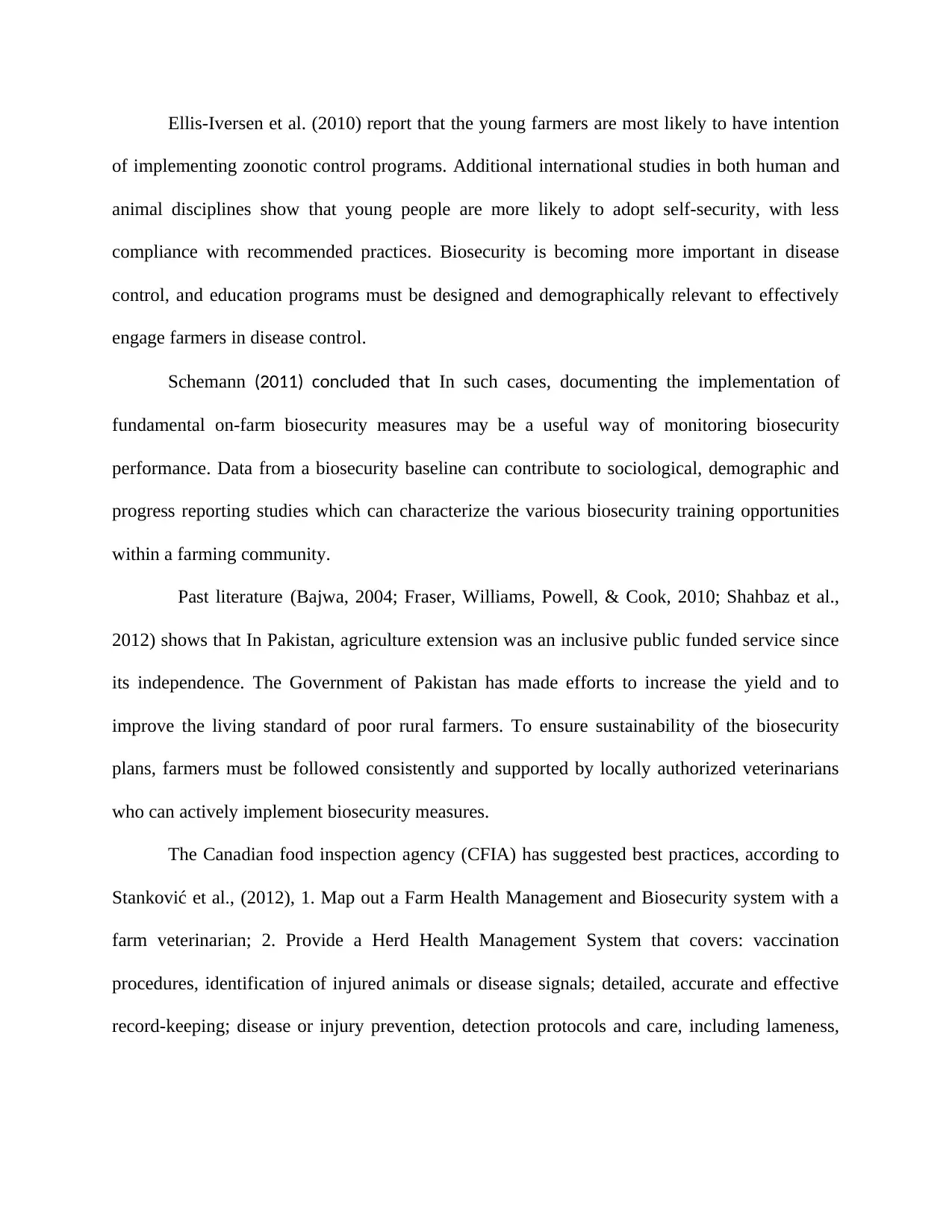
of implementing zoonotic control programs. Additional international studies in both human and
animal disciplines show that young people are more likely to adopt self-security, with less
compliance with recommended practices. Biosecurity is becoming more important in disease
control, and education programs must be designed and demographically relevant to effectively
engage farmers in disease control.
Schemann (2011) concluded that In such cases, documenting the implementation of
fundamental on-farm biosecurity measures may be a useful way of monitoring biosecurity
performance. Data from a biosecurity baseline can contribute to sociological, demographic and
progress reporting studies which can characterize the various biosecurity training opportunities
within a farming community.
Past literature (Bajwa, 2004; Fraser, Williams, Powell, & Cook, 2010; Shahbaz et al.,
2012) shows that In Pakistan, agriculture extension was an inclusive public funded service since
its independence. The Government of Pakistan has made efforts to increase the yield and to
improve the living standard of poor rural farmers. To ensure sustainability of the biosecurity
plans, farmers must be followed consistently and supported by locally authorized veterinarians
who can actively implement biosecurity measures.
The Canadian food inspection agency (CFIA) has suggested best practices, according to
Stanković et al., (2012), 1. Map out a Farm Health Management and Biosecurity system with a
farm veterinarian; 2. Provide a Herd Health Management System that covers: vaccination
procedures, identification of injured animals or disease signals; detailed, accurate and effective
record-keeping; disease or injury prevention, detection protocols and care, including lameness,

handling programs and protocols
Feasting and irrigation may be considered good for all farms observed, but pathogens
may be introduced in the herd at any time, particularly for younger categories, because of a
problem of mixed-use of equipment and vehicles in both feedstock and waste management and
transportation. (Stankovic, et al., 2012).
Sayers has shown that medicine and vaccination have historically played an important
role in disease prevention and diagnosis, but that they cannot prevent any disease loss by
themselves in isolation, and modern agriculture needs an overall and more systematic approach.
Therefore, a robust biosecurity system to optimize the resistance of diseases and reduce exposure
from the flock to infectious agents is important. (Sayers, 2014).
The underlying foundation of herd health planning and disease control in past anonymous
literature (2014) is the empirical risk analysis. The probability of a disease's incidence and its
effects should be analyzed as a disease risk study. Epidemiological work is necessary to provide
the data required for thorough risk analysis on biosafety, the prevalence of the disease,
vaccination, and productivity loss associated with a specific infectious agent.
The advantages of biosecurity planning have been explored in many countries (Hristov,
Stanković, Maksimović, Ostojić, Andrić, & Zlatanović, 2013). Moreover, have moved many
countries to establish business identifier code (BIC) standards and strategies for a general or
particular purpose, with significant consequences for national dairy production that enhance its
international competitiveness. It is intended to allow sustainable milking, balance productivity
with environmental responsibility, introduce realistic and farm-oriented environmental solutions,
reduce costs for farmers and increase their production.
⊘ This is a preview!⊘
Do you want full access?
Subscribe today to unlock all pages.

Trusted by 1+ million students worldwide
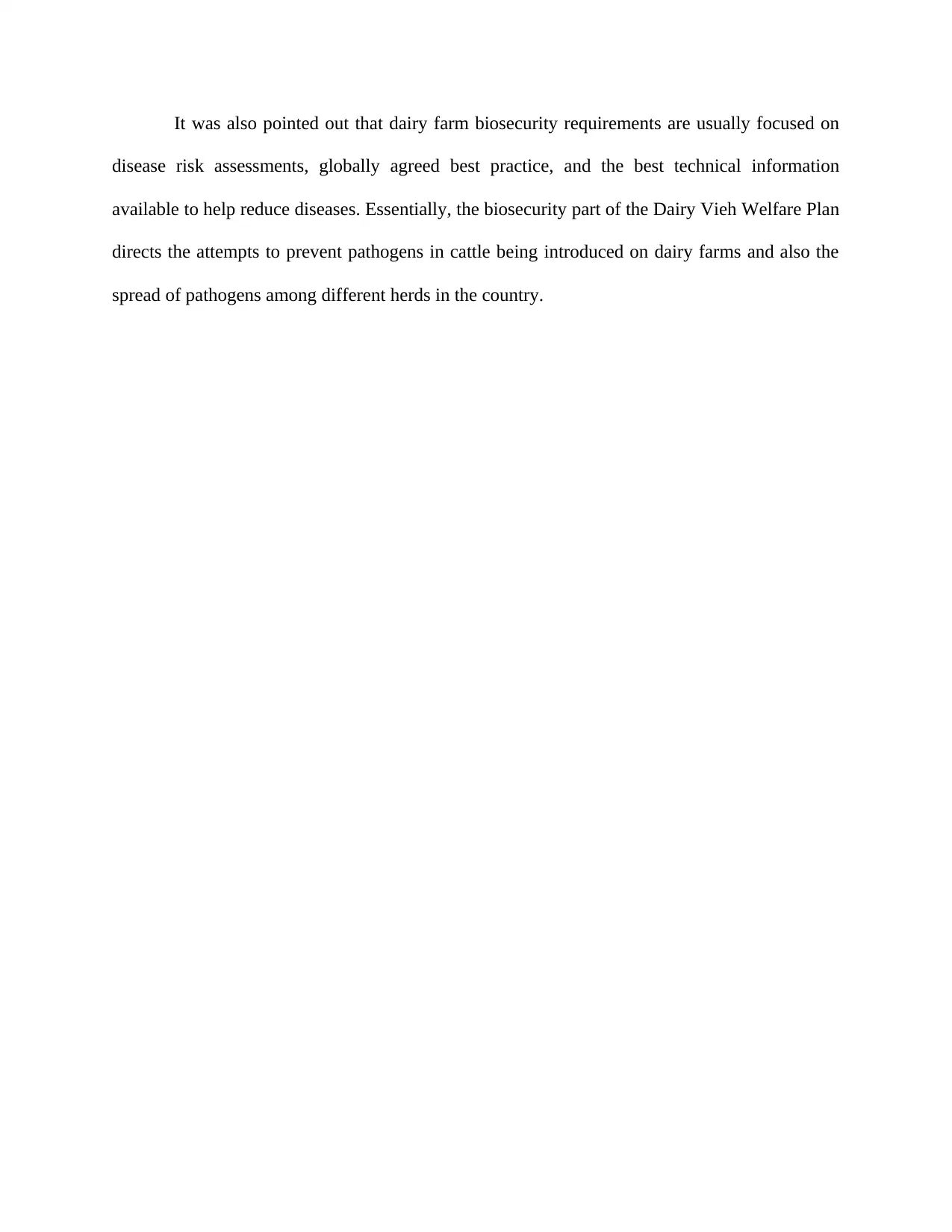
disease risk assessments, globally agreed best practice, and the best technical information
available to help reduce diseases. Essentially, the biosecurity part of the Dairy Vieh Welfare Plan
directs the attempts to prevent pathogens in cattle being introduced on dairy farms and also the
spread of pathogens among different herds in the country.
Paraphrase This Document

MATERIALS AND METHODS
3.1 INTRODUCTION
This chapter aims to clarify the various methods and techniques used to evaluate, and
interpret the data on dairy farmer’s biosafety measures in Pothwar. A specific method is utilized
for conduct of the survey. This chapter provided the researcher with an understanding of the
work to complete the data collection, analysis and interpretation process. By using this method,
problems are easily resolved by the researcher.
3.2 STUDY AREA
The present work will be carried out in Pothwar region, Punjab Pakistan. This region
consists of four districts Attock, Jhelum, Chakwal, and Rawalpindi. Its total area is
approximately 23,000 km2 with an elevation of 366–580m above the mean sea level (Panhwar,
Zaidi, Ullah, & Edgar, 2020). It is slected for study because of it’s prime importance related to
agriculture and livestock. In case of livestock, different types of breeds are found and mostly
people in this area are engaged livestock as a commercial business.
3.3 SAMPLES FOR THE STUDY
A multi stage random sampling method will be used for site selection and respondents, as the
analysis principle will be quantitative. As the Pothwar region consists of four districts Attock,
Jhelum, Chakwal and Rawalpindi so at the first step, two districts of the Pothwar will be selected
randomly. Three tehsils from each district will be selected through random sampling techniques
at the second step. Then three union councils from each selected tehsils will be chosen at random
as third. At fourth step, four villages will be select from each selected union council. In the final
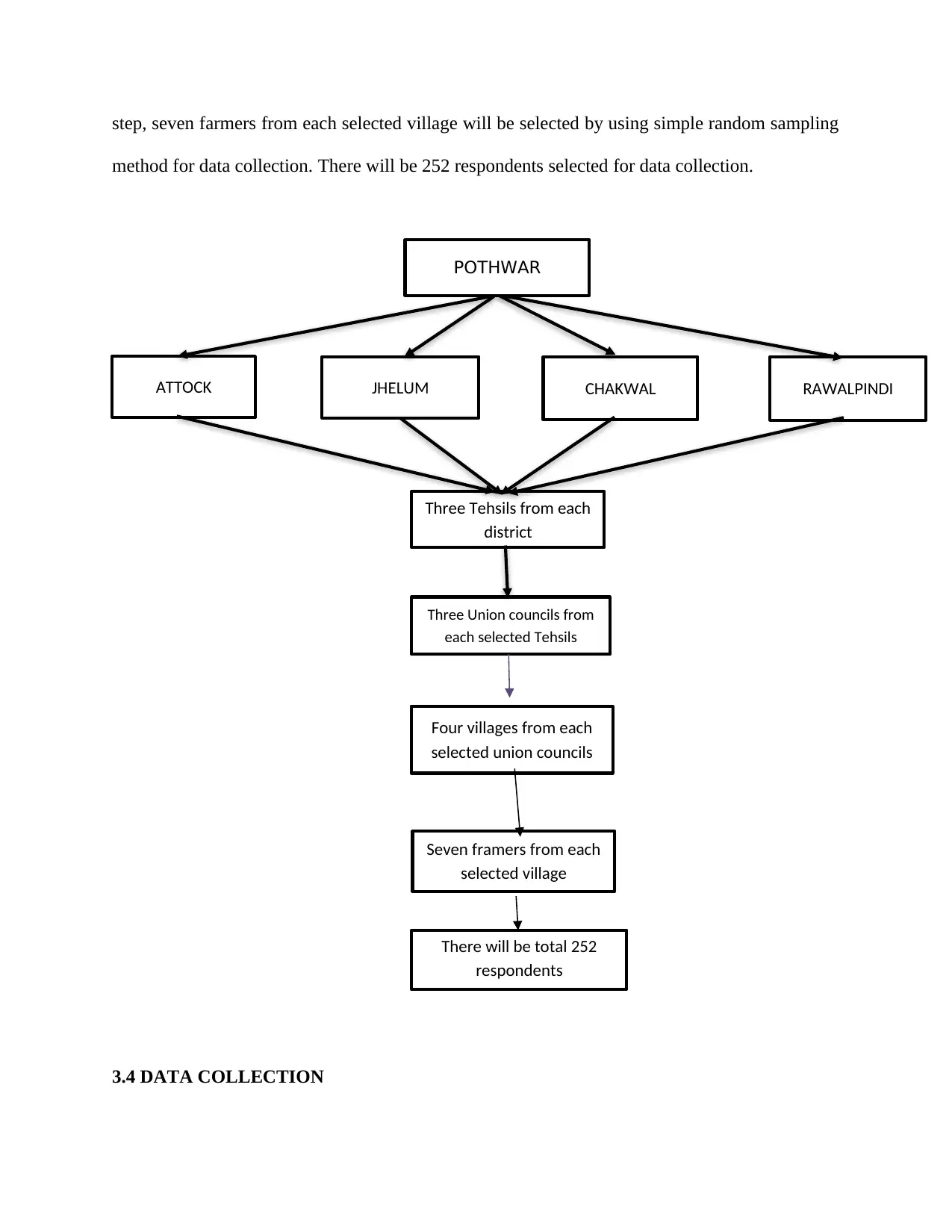
method for data collection. There will be 252 respondents selected for data collection.
3.4 DATA COLLECTION
ATTOCK JHELUM CHAKWAL RAWALPINDI
Three Tehsils from each
district
Three Union councils from
each selected Tehsils
Four villages from each
selected union councils
Seven framers from each
selected village
There will be total 252
respondents
POTHWAR
⊘ This is a preview!⊘
Do you want full access?
Subscribe today to unlock all pages.

Trusted by 1+ million students worldwide
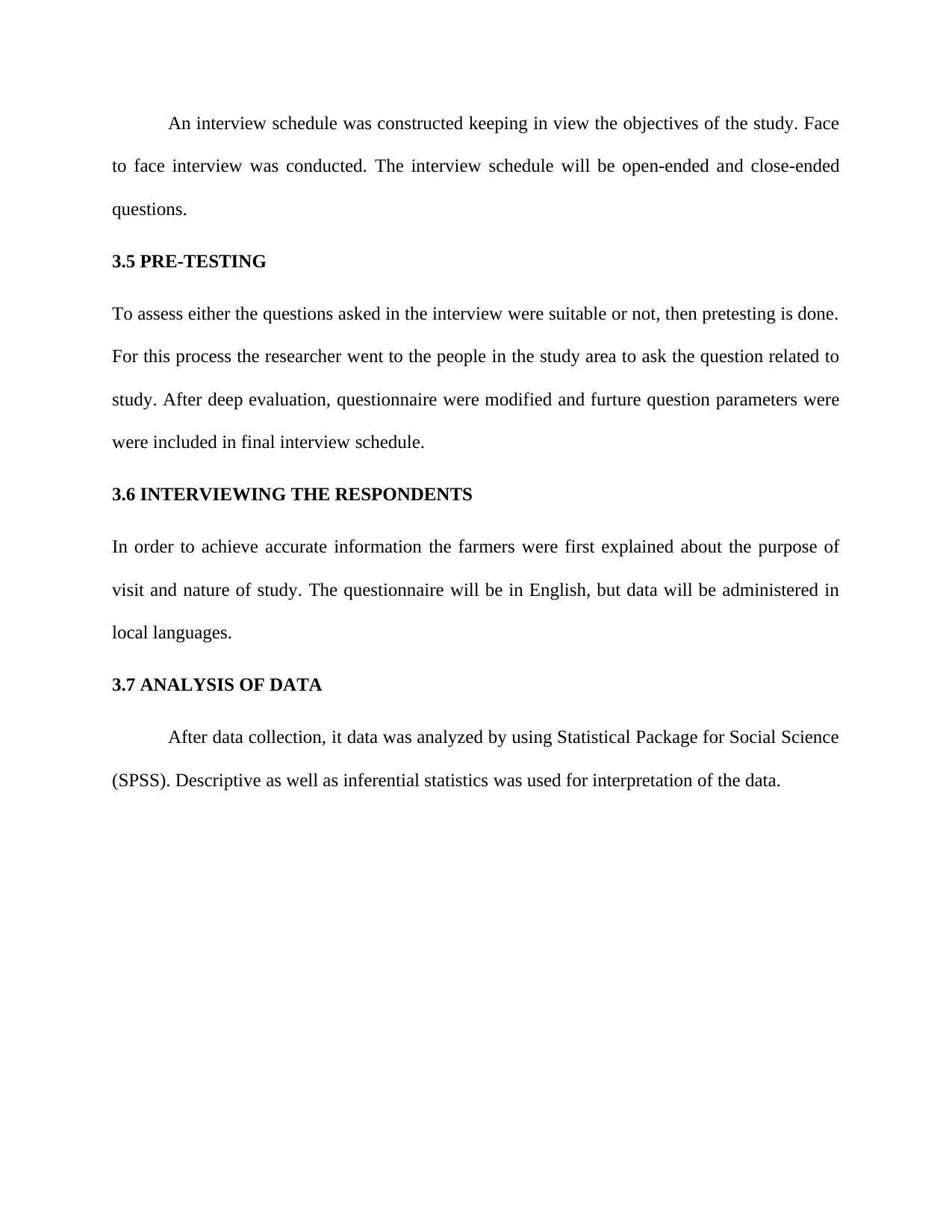
to face interview was conducted. The interview schedule will be open-ended and close-ended
questions.
3.5 PRE-TESTING
To assess either the questions asked in the interview were suitable or not, then pretesting is done.
For this process the researcher went to the people in the study area to ask the question related to
study. After deep evaluation, questionnaire were modified and furture question parameters were
were included in final interview schedule.
3.6 INTERVIEWING THE RESPONDENTS
In order to achieve accurate information the farmers were first explained about the purpose of
visit and nature of study. The questionnaire will be in English, but data will be administered in
local languages.
3.7 ANALYSIS OF DATA
After data collection, it data was analyzed by using Statistical Package for Social Science
(SPSS). Descriptive as well as inferential statistics was used for interpretation of the data.
Paraphrase This Document
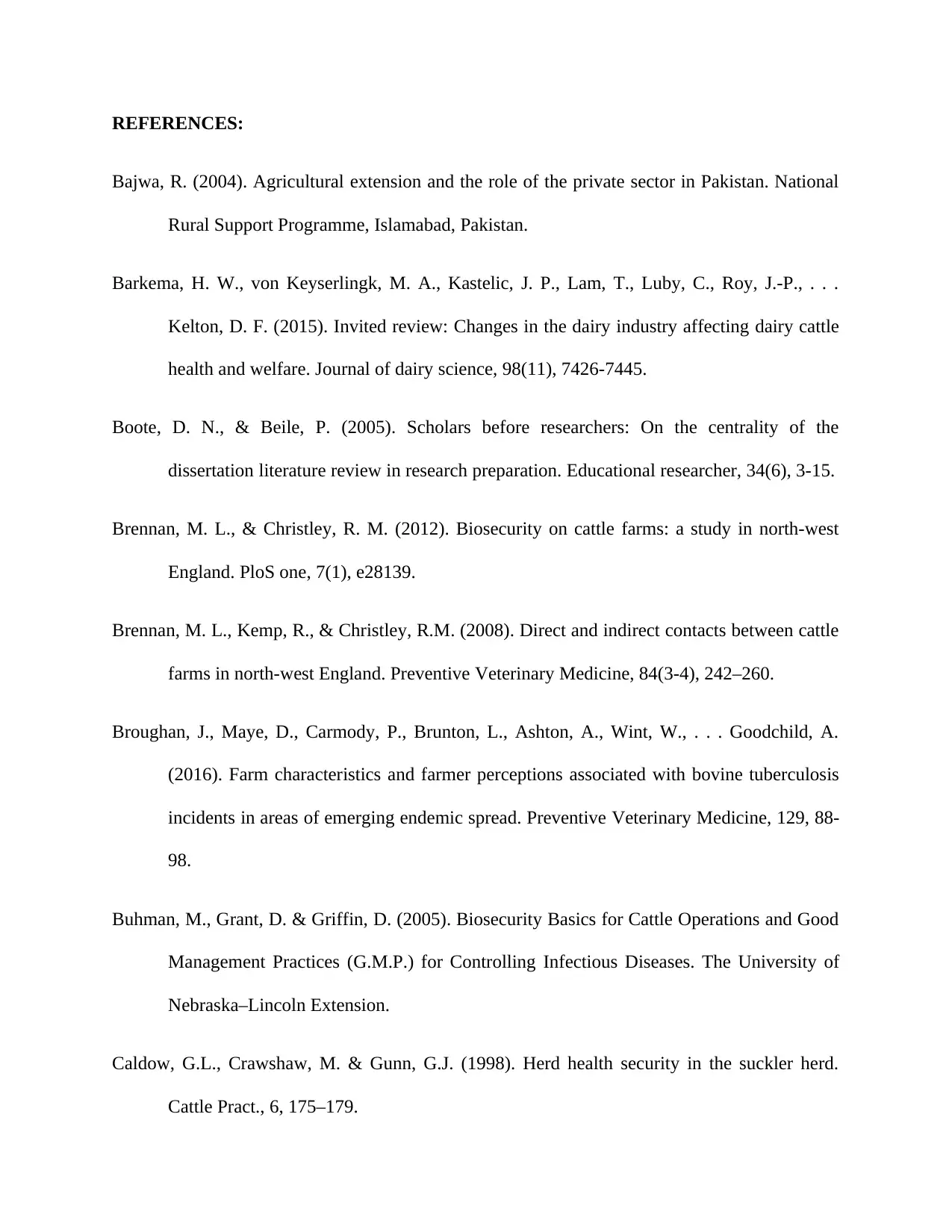
Bajwa, R. (2004). Agricultural extension and the role of the private sector in Pakistan. National
Rural Support Programme, Islamabad, Pakistan.
Barkema, H. W., von Keyserlingk, M. A., Kastelic, J. P., Lam, T., Luby, C., Roy, J.-P., . . .
Kelton, D. F. (2015). Invited review: Changes in the dairy industry affecting dairy cattle
health and welfare. Journal of dairy science, 98(11), 7426-7445.
Boote, D. N., & Beile, P. (2005). Scholars before researchers: On the centrality of the
dissertation literature review in research preparation. Educational researcher, 34(6), 3-15.
Brennan, M. L., & Christley, R. M. (2012). Biosecurity on cattle farms: a study in north-west
England. PloS one, 7(1), e28139.
Brennan, M. L., Kemp, R., & Christley, R.M. (2008). Direct and indirect contacts between cattle
farms in north-west England. Preventive Veterinary Medicine, 84(3-4), 242–260.
Broughan, J., Maye, D., Carmody, P., Brunton, L., Ashton, A., Wint, W., . . . Goodchild, A.
(2016). Farm characteristics and farmer perceptions associated with bovine tuberculosis
incidents in areas of emerging endemic spread. Preventive Veterinary Medicine, 129, 88-
98.
Buhman, M., Grant, D. & Griffin, D. (2005). Biosecurity Basics for Cattle Operations and Good
Management Practices (G.M.P.) for Controlling Infectious Diseases. The University of
Nebraska–Lincoln Extension.
Caldow, G.L., Crawshaw, M. & Gunn, G.J. (1998). Herd health security in the suckler herd.
Cattle Pract., 6, 175–179.
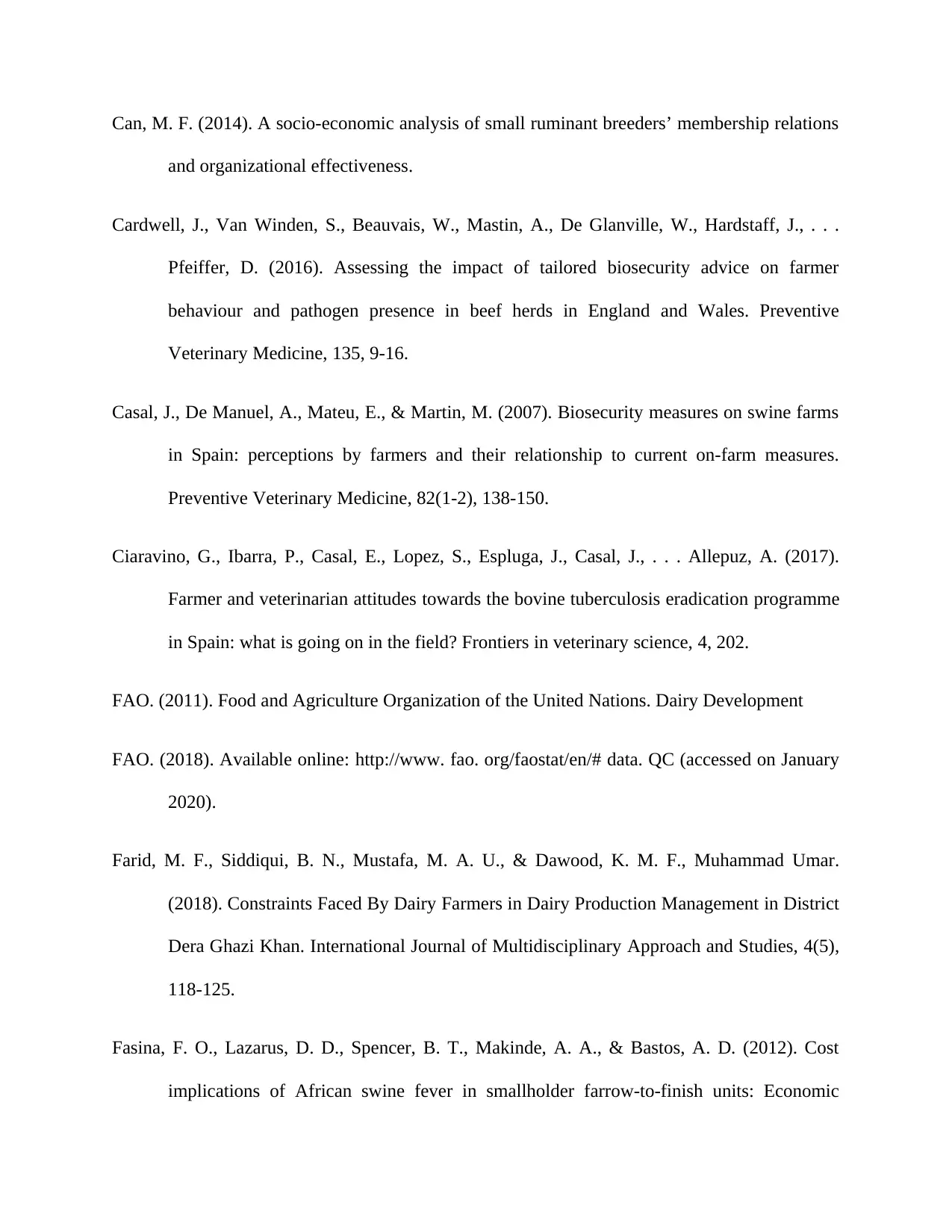
and organizational effectiveness.
Cardwell, J., Van Winden, S., Beauvais, W., Mastin, A., De Glanville, W., Hardstaff, J., . . .
Pfeiffer, D. (2016). Assessing the impact of tailored biosecurity advice on farmer
behaviour and pathogen presence in beef herds in England and Wales. Preventive
Veterinary Medicine, 135, 9-16.
Casal, J., De Manuel, A., Mateu, E., & Martin, M. (2007). Biosecurity measures on swine farms
in Spain: perceptions by farmers and their relationship to current on-farm measures.
Preventive Veterinary Medicine, 82(1-2), 138-150.
Ciaravino, G., Ibarra, P., Casal, E., Lopez, S., Espluga, J., Casal, J., . . . Allepuz, A. (2017).
Farmer and veterinarian attitudes towards the bovine tuberculosis eradication programme
in Spain: what is going on in the field? Frontiers in veterinary science, 4, 202.
FAO. (2011). Food and Agriculture Organization of the United Nations. Dairy Development
FAO. (2018). Available online: http://www. fao. org/faostat/en/# data. QC (accessed on January
2020).
Farid, M. F., Siddiqui, B. N., Mustafa, M. A. U., & Dawood, K. M. F., Muhammad Umar.
(2018). Constraints Faced By Dairy Farmers in Dairy Production Management in District
Dera Ghazi Khan. International Journal of Multidisciplinary Approach and Studies, 4(5),
118-125.
Fasina, F. O., Lazarus, D. D., Spencer, B. T., Makinde, A. A., & Bastos, A. D. (2012). Cost
implications of African swine fever in smallholder farrow‐to‐finish units: Economic
⊘ This is a preview!⊘
Do you want full access?
Subscribe today to unlock all pages.

Trusted by 1+ million students worldwide
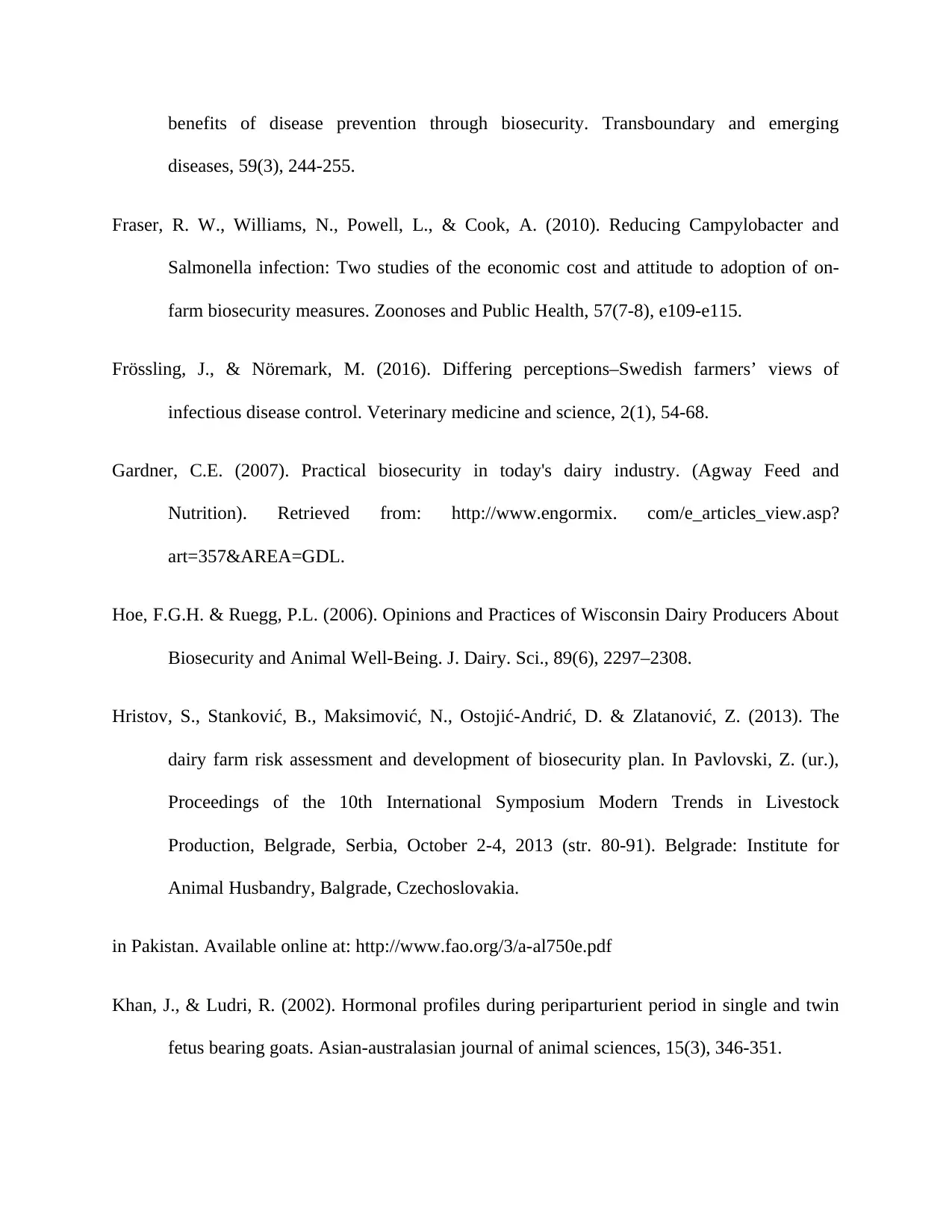
diseases, 59(3), 244-255.
Fraser, R. W., Williams, N., Powell, L., & Cook, A. (2010). Reducing Campylobacter and
Salmonella infection: Two studies of the economic cost and attitude to adoption of on‐
farm biosecurity measures. Zoonoses and Public Health, 57(7‐8), e109-e115.
Frössling, J., & Nöremark, M. (2016). Differing perceptions–Swedish farmers’ views of
infectious disease control. Veterinary medicine and science, 2(1), 54-68.
Gardner, C.E. (2007). Practical biosecurity in today's dairy industry. (Agway Feed and
Nutrition). Retrieved from: http://www.engormix. com/e_articles_view.asp?
art=357&AREA=GDL.
Hoe, F.G.H. & Ruegg, P.L. (2006). Opinions and Practices of Wisconsin Dairy Producers About
Biosecurity and Animal Well-Being. J. Dairy. Sci., 89(6), 2297–2308.
Hristov, S., Stanković, B., Maksimović, N., Ostojić-Andrić, D. & Zlatanović, Z. (2013). The
dairy farm risk assessment and development of biosecurity plan. In Pavlovski, Z. (ur.),
Proceedings of the 10th International Symposium Modern Trends in Livestock
Production, Belgrade, Serbia, October 2-4, 2013 (str. 80-91). Belgrade: Institute for
Animal Husbandry, Balgrade, Czechoslovakia.
in Pakistan. Available online at: http://www.fao.org/3/a-al750e.pdf
Khan, J., & Ludri, R. (2002). Hormonal profiles during periparturient period in single and twin
fetus bearing goats. Asian-australasian journal of animal sciences, 15(3), 346-351.
Paraphrase This Document

opinion on the perceived effectiveness and importance of on-farm biosecurity measures
for cattle and swine farms in Switzerland. PloS one, 10(12), e0144533.
Laanen, M., Persoons, D., Ribbens, S., de Jong, E., Callens, B., Strubbe, M., . . . Dewulf, J.
(2013). Relationship between biosecurity and production/antimicrobial treatment
characteristics in pig herds. The Veterinary Journal, 198(2), 508-512.
Masters, W. A., Djurfeldt, A. A., De Haan, C., Hazell, P., Jayne, T., Jirström, M., & Reardon, T.
(2013). Urbanization and farm size in Asia and Africa: Implications for food security and
agricultural research. Global Food Security, 2(3), 156-165.
Mikkelsen, T., Alexandersen, S., Astrup, P., Champion, H.J., Donaldson, A.I., Dunkerley, F.N.,
Gloster, J., Sorensen, J.H., Thykier-Nielsen, S. (2003). Investigation of airborne foot-and-
mouth disease virus transmission during low-wind conditions in the early phase of the
U.K. 2001 epidemic. Atmos. Chem. Phys., 3, 2101–2110.
Moore, D. A., Merryman, M. L., Hartman, M. L., & Klingborg, D. J. (2008). Comparison of
published recommendations regarding biosecurity practices for various production animal
species and classes. Journal of the American Veterinary Medical Association, 233(2),
249-256.
Nold, R. (2007). Biosecurity: Protecting Your Health and the Health of Your Animals.
University of Nebraska - Lincoln Extension, Institute of Agriculture and Natural
Resources. Retrieved from: www.exstension. unl.edu/publications.
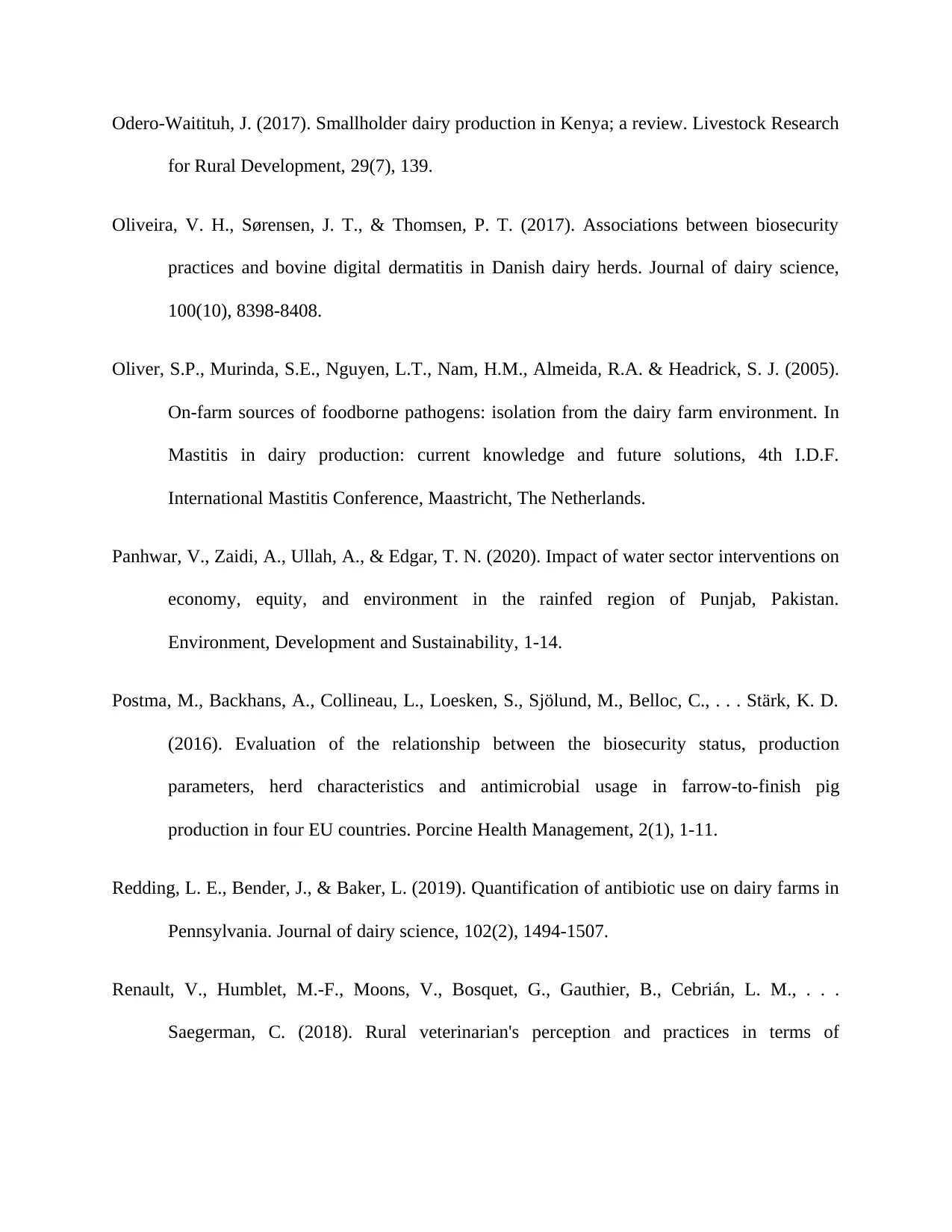
for Rural Development, 29(7), 139.
Oliveira, V. H., Sørensen, J. T., & Thomsen, P. T. (2017). Associations between biosecurity
practices and bovine digital dermatitis in Danish dairy herds. Journal of dairy science,
100(10), 8398-8408.
Oliver, S.P., Murinda, S.E., Nguyen, L.T., Nam, H.M., Almeida, R.A. & Headrick, S. J. (2005).
On-farm sources of foodborne pathogens: isolation from the dairy farm environment. In
Mastitis in dairy production: current knowledge and future solutions, 4th I.D.F.
International Mastitis Conference, Maastricht, The Netherlands.
Panhwar, V., Zaidi, A., Ullah, A., & Edgar, T. N. (2020). Impact of water sector interventions on
economy, equity, and environment in the rainfed region of Punjab, Pakistan.
Environment, Development and Sustainability, 1-14.
Postma, M., Backhans, A., Collineau, L., Loesken, S., Sjölund, M., Belloc, C., . . . Stärk, K. D.
(2016). Evaluation of the relationship between the biosecurity status, production
parameters, herd characteristics and antimicrobial usage in farrow-to-finish pig
production in four EU countries. Porcine Health Management, 2(1), 1-11.
Redding, L. E., Bender, J., & Baker, L. (2019). Quantification of antibiotic use on dairy farms in
Pennsylvania. Journal of dairy science, 102(2), 1494-1507.
Renault, V., Humblet, M.-F., Moons, V., Bosquet, G., Gauthier, B., Cebrián, L. M., . . .
Saegerman, C. (2018). Rural veterinarian's perception and practices in terms of
⊘ This is a preview!⊘
Do you want full access?
Subscribe today to unlock all pages.

Trusted by 1+ million students worldwide
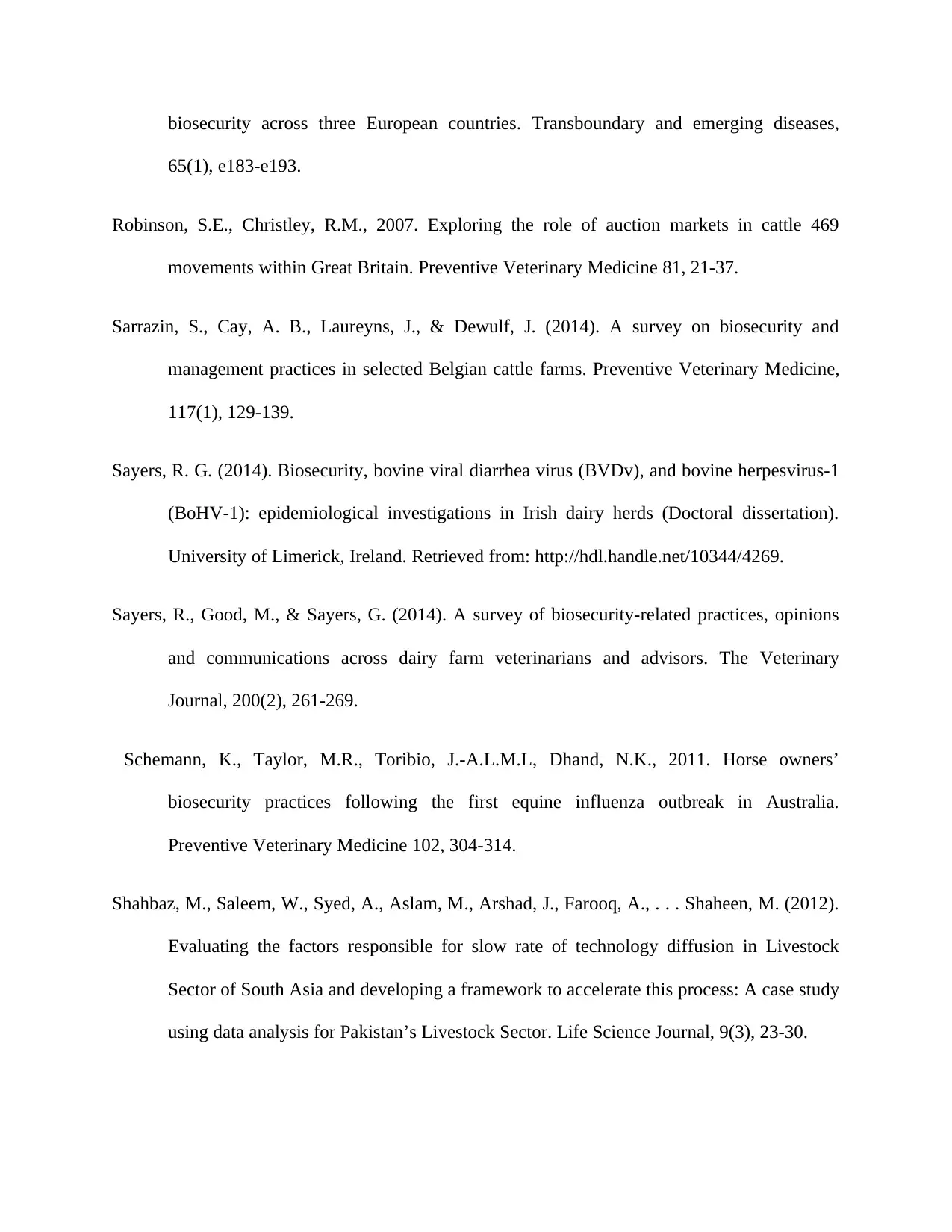
65(1), e183-e193.
Robinson, S.E., Christley, R.M., 2007. Exploring the role of auction markets in cattle 469
movements within Great Britain. Preventive Veterinary Medicine 81, 21-37.
Sarrazin, S., Cay, A. B., Laureyns, J., & Dewulf, J. (2014). A survey on biosecurity and
management practices in selected Belgian cattle farms. Preventive Veterinary Medicine,
117(1), 129-139.
Sayers, R. G. (2014). Biosecurity, bovine viral diarrhea virus (BVDv), and bovine herpesvirus-1
(BoHV-1): epidemiological investigations in Irish dairy herds (Doctoral dissertation).
University of Limerick, Ireland. Retrieved from: http://hdl.handle.net/10344/4269.
Sayers, R., Good, M., & Sayers, G. (2014). A survey of biosecurity-related practices, opinions
and communications across dairy farm veterinarians and advisors. The Veterinary
Journal, 200(2), 261-269.
Schemann, K., Taylor, M.R., Toribio, J.-A.L.M.L, Dhand, N.K., 2011. Horse owners’
biosecurity practices following the first equine influenza outbreak in Australia.
Preventive Veterinary Medicine 102, 304-314.
Shahbaz, M., Saleem, W., Syed, A., Aslam, M., Arshad, J., Farooq, A., . . . Shaheen, M. (2012).
Evaluating the factors responsible for slow rate of technology diffusion in Livestock
Sector of South Asia and developing a framework to accelerate this process: A case study
using data analysis for Pakistan’s Livestock Sector. Life Science Journal, 9(3), 23-30.
Paraphrase This Document
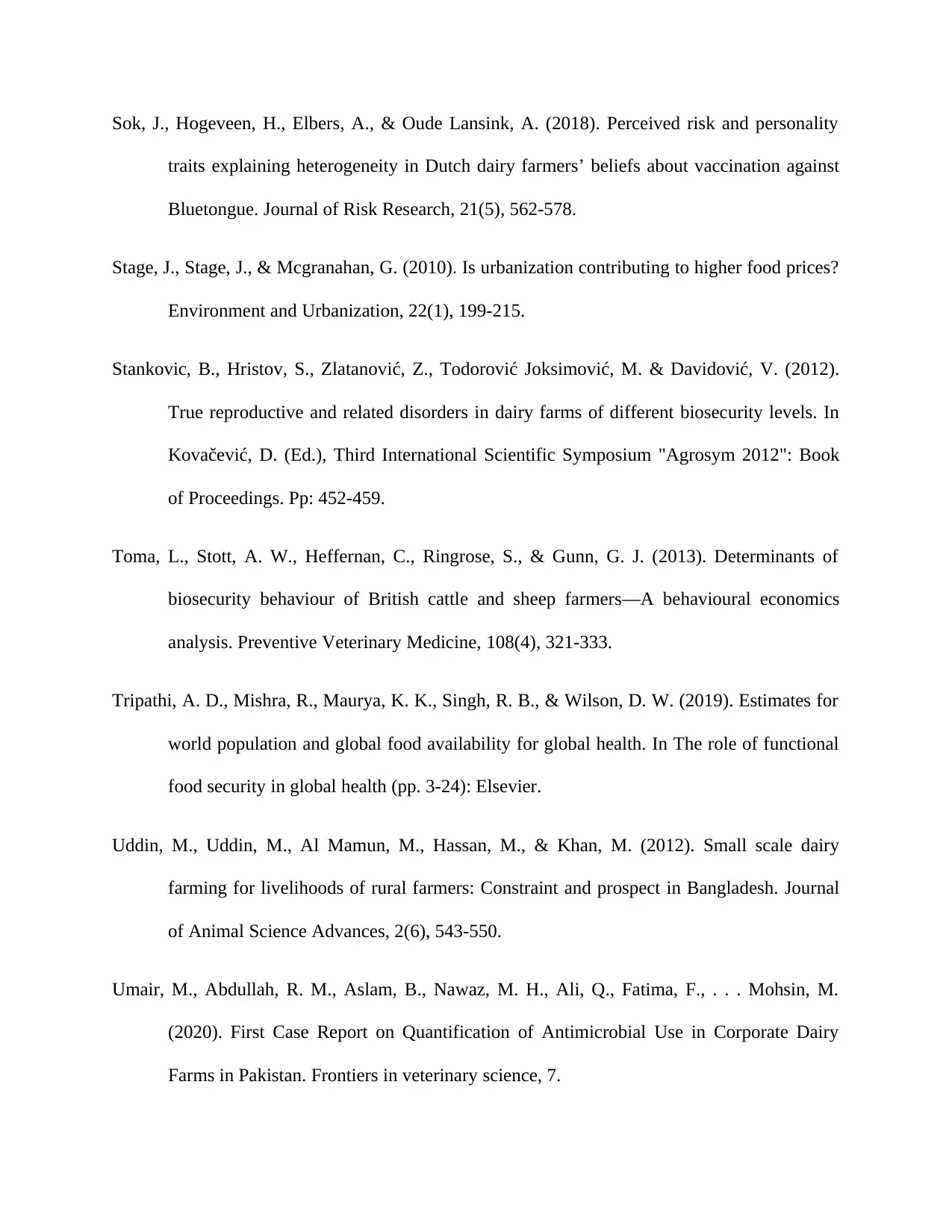
traits explaining heterogeneity in Dutch dairy farmers’ beliefs about vaccination against
Bluetongue. Journal of Risk Research, 21(5), 562-578.
Stage, J., Stage, J., & Mcgranahan, G. (2010). Is urbanization contributing to higher food prices?
Environment and Urbanization, 22(1), 199-215.
Stankovic, B., Hristov, S., Zlatanović, Z., Todorović Joksimović, M. & Davidović, V. (2012).
True reproductive and related disorders in dairy farms of different biosecurity levels. In
Kovačević, D. (Ed.), Third International Scientific Symposium "Agrosym 2012": Book
of Proceedings. Pp: 452-459.
Toma, L., Stott, A. W., Heffernan, C., Ringrose, S., & Gunn, G. J. (2013). Determinants of
biosecurity behaviour of British cattle and sheep farmers—A behavioural economics
analysis. Preventive Veterinary Medicine, 108(4), 321-333.
Tripathi, A. D., Mishra, R., Maurya, K. K., Singh, R. B., & Wilson, D. W. (2019). Estimates for
world population and global food availability for global health. In The role of functional
food security in global health (pp. 3-24): Elsevier.
Uddin, M., Uddin, M., Al Mamun, M., Hassan, M., & Khan, M. (2012). Small scale dairy
farming for livelihoods of rural farmers: Constraint and prospect in Bangladesh. Journal
of Animal Science Advances, 2(6), 543-550.
Umair, M., Abdullah, R. M., Aslam, B., Nawaz, M. H., Ali, Q., Fatima, F., . . . Mohsin, M.
(2020). First Case Report on Quantification of Antimicrobial Use in Corporate Dairy
Farms in Pakistan. Frontiers in veterinary science, 7.
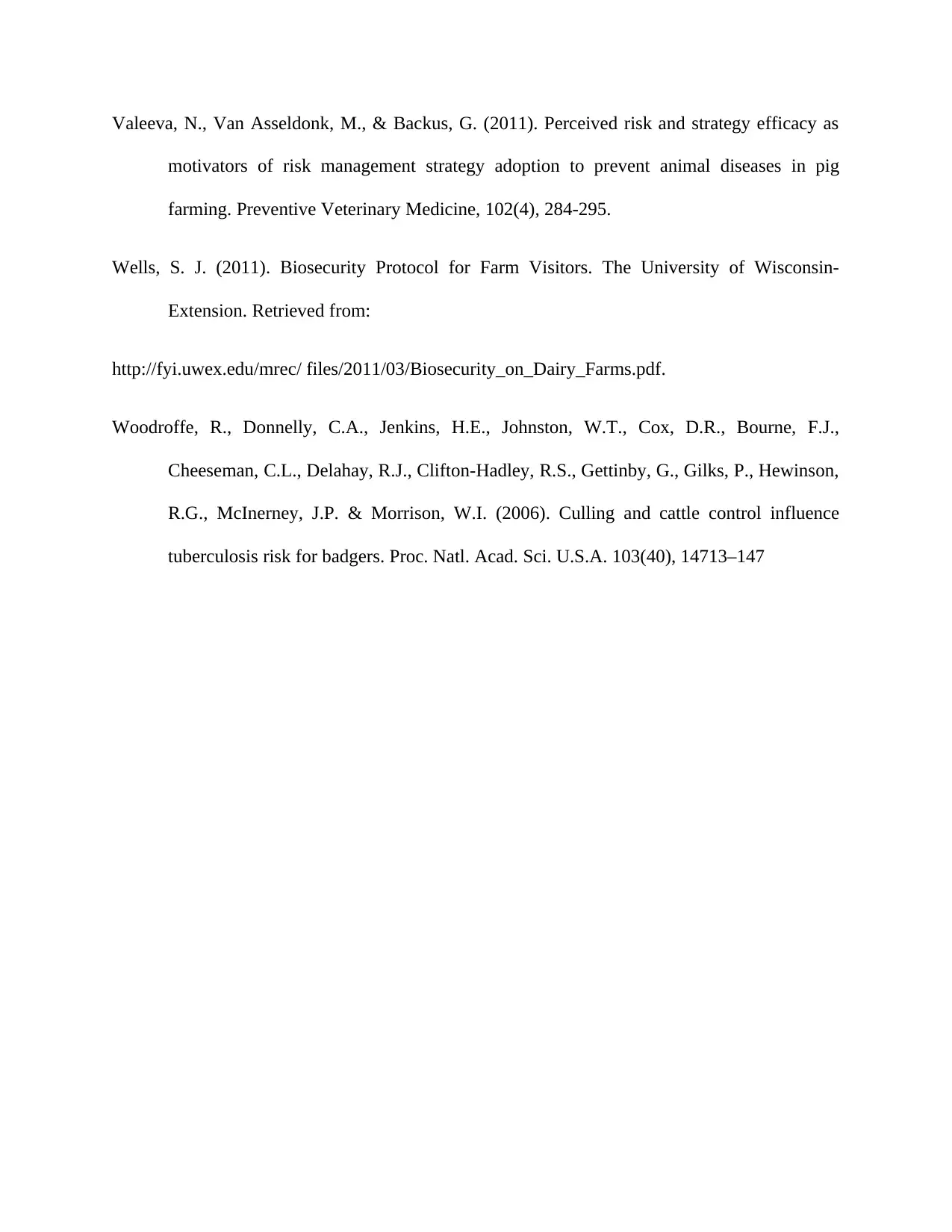
motivators of risk management strategy adoption to prevent animal diseases in pig
farming. Preventive Veterinary Medicine, 102(4), 284-295.
Wells, S. J. (2011). Biosecurity Protocol for Farm Visitors. The University of Wisconsin-
Extension. Retrieved from:
http://fyi.uwex.edu/mrec/ files/2011/03/Biosecurity_on_Dairy_Farms.pdf.
Woodroffe, R., Donnelly, C.A., Jenkins, H.E., Johnston, W.T., Cox, D.R., Bourne, F.J.,
Cheeseman, C.L., Delahay, R.J., Clifton-Hadley, R.S., Gettinby, G., Gilks, P., Hewinson,
R.G., McInerney, J.P. & Morrison, W.I. (2006). Culling and cattle control influence
tuberculosis risk for badgers. Proc. Natl. Acad. Sci. U.S.A. 103(40), 14713–147
⊘ This is a preview!⊘
Do you want full access?
Subscribe today to unlock all pages.

Trusted by 1+ million students worldwide
Your All-in-One AI-Powered Toolkit for Academic Success.
+13062052269
info@desklib.com
Available 24*7 on WhatsApp / Email
![[object Object]](/_next/static/media/star-bottom.7253800d.svg)
© 2024 | Zucol Services PVT LTD | All rights reserved.
